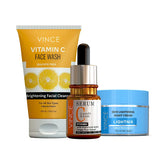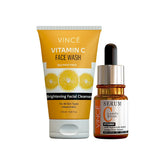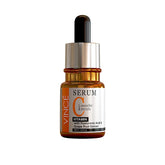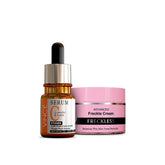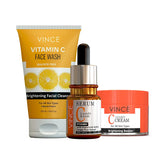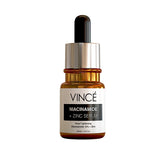Pigmentation: Causes, Types, and Effective Ways to Treat It

The struggle with skin problems often feels like a never-ending puzzle, and among them, all is a persistent case of stubborn skin pigmentation. It is a common condition that pops up unexpectedly, leaving everyone searching for answers on how to reduce melanin production to achieve even skin tone.
The first step is understanding the basic causes of skin pigmentation, paving the way to effective uneven skin tone solutions.
Whether effective hyperpigmentation treatment is your latest quest or you are seeking melasma treatment, there are various solutions, from natural remedies for pigmentation to brightening creams for dark spots.
These dark spot removal techniques effectively repair your skin, rescuing it from the relentless clutches of sun damage and pigmentation.
Here's your one-stop resource for understanding skin pigmentation, guiding you through its causes, types, and solutions, and designed to breathe new life into the skin’s natural glow.
Skin Pigmentation: An Introduction
Every shadow that torments flawless skin often introduces individuals to the term skin pigmentation. Here’s a simple way to understand it:
Pigmentation is a natural process, a deciding factor in the unique blend of our skin tones reflecting the amount of melanin produced by our cells. Melanin is a substance that paints our skin, hair, and eyes with unique hues, serving as our unsung savior by shielding us from UV rays and environmental stressors.
However, once the balance is disturbed, it results in melanin overproduction, underproduction, or uneven distribution. This condition, aptly named skin pigmentation, causes dark spots, patches, and other irregularities on the skin that can lead to uneven skin tone.
Causes of Skin Pigmentation
Before jumping to uneven skin tone solutions, satisfy your curiosity about what drives pigmentation in the first place. The root causes of skin pigmentation stem from the following:
Sun Damage and Pigmentation
When you list the primary causes of skin pigmentation, the relentless sun rays take the crown. Prolonged exposure to these UV rays without a protective layer of sunscreen triggers melanin overproduction as an attempt to safeguard skin from its harmful effects.
The increased levels of melanin dark spots disturb the natural balance and lead to the formation of dark spots and freckles.
Intrinsic Factors
One of the leading causes of skin pigmentation is an individual’s genetic makeup and the inevitable process of aging. However, some individuals may also develop dark spots due to hormonal fluctuations, especially during pregnancy or oral contraceptives.
Inflammation
Individuals often experience dark spots when melanin overproduction is brought on by inflammation from injury, acne or other skin conditions like eczema and psoriasis. This type of skin pigmentation falls under the umbrella of post-inflammatory hyperpigmentation.
Important Link: How to Get Rid of Combination Skin
Medical Conditions and Medications
Sometimes, skin pigmentation occurs as a side effect of various medical conditions or certain medications like chemotherapy drugs. It disturbs the skin’s natural clarity, plaguing it with an uneven tone and discoloration.

Types of Skin Pigmentation
Characterized by varying sizes, shapes, and colors, the following are the common types of skin pigmentation to help you recognize the exact category you may be enduring:
Hyperpigmentation:
This skin pigmentation type is associated with an overproduction of melanin and is the most common reason many individuals have dark spots and uneven tones. It serves as a broader umbrella that further encapsulates subtypes as follows:
1: Melasma
It refers to the appearance of brown to gray-brown patches usually on the face and appears due to hormonal imbalance, commonly during pregnancy or when using birth control pills.
2: Post-inflammatory hyperpigmentation
Once the skin has recovered from an injury or inflammatory condition, it may leave behind dark spots or patches caused by increased melanin levels during the healing process. This condition is known as Post-inflammatory hyperpigmentation and is characterized by acne, eczema, trauma, burns, or cuts.
3: Freckles
Freckles are commonly observed in people with fair complexions, where sun exposure or genetic factors trigger small, tan, or brown spots. People often assume freckles are untreatable, but Vince’s Advanced Freckle Cream, with its well-crafted formula, can prove them wrong by fading those stubborn marks in no time.

Hypopigmentation
It is a condition caused by the underproduction of melanin, resulting in skin color appearing paler than its normal shade, affecting either a small region or the entire body.
Important Link: Is Daily Exfoliation Good For Skin?
How to Reduce Melanin Production: Tips for Brighter Complexion
The effective hyperpigmentation treatments work by inhibiting melanin production and lightening the skin tone. To achieve this outcome, never take the following tips lightly:
Never Skip Sunscreen
Sun damage and skin pigmentation are interlinked, thus imposing the importance of sunblock for inhibiting melanin imbalance. Always wear a broad-spectrum sunscreen with SPF 30 or above.
Befriend Serums
Serums are concentrated solutions that melt on your skin to restore it from the inside. Uneven skin tone solutions are incomplete without the presence of the following skincare essentials:
1: Niacinamide:
Its introduction as an antioxidant automatically qualifies this ingredient to reduce dark spots, even skin tone, and inhibit melanin production.
2: Vitamin C:
It is a gold-standard skin-brightening ingredient for treating dark spots while protecting and repairing skin against sun damage by neutralizing free radicals. Opt for any Vitamin C-based product, and the results will surely surprise you.
3: Retinol:
It boosts collagen production and increases cell turnover to fade dark spots and reveal smooth texture and even skin tone.
Hyperpigmentation Treatment: Effective Ways to Treat Skin Pigmentation
Hyperpigmentation is harmless but still holds the power to dent your confidence by very much standing in the way of achieving dreamy, balanced skin. If the signs of hyperpigmentation show up on your face, we have a number of solutions that will help you restore your clear, glassy complexion with consistent use.
Natural Remedies for Pigmentation
If you are scared of harsh solutions for hyperpigmentation and melasma treatment, then you can opt for the gentle touch of natural remedies to solve your problem.
Aloe Vera
Pure aloe vera gel is naturally infused with skin brightening ability and offers non-toxic hyperpigmentation treatment. For accelerated yet gentle effects, you can start your skincare routine with clarifying Aloe Vera Face Wash, as it's overflowing with the goodness of aloe vera to promote radiant skin.

Green Tea
It has depigmentation effects, so you can directly apply green extract or even use green tea bags on dark spots to witness its lightening benefits.
Apple Cider Vinegar
The acetic acid present in apple cider vinegar helps lighten skin pigmentation concerns, but always dilute it with equal water to avoid skin irritation.
Brightening Creams for Dark Spots
Nothing works as swiftly as the magically designed skincare products, designed with the finest set of ingredients to combat skin pigmentation. Following are the must-have brightening creams for dark spots that your skin deserves for treating pigmentation concerns:
Extra Strength Lightening Cream
The dream of magically attaining luminous skin with even tone has never been easier. Incorporate this top-ranked product in your routine to appreciate the difference yourself. It is formulated with deep-acting and potent lightening agents that work 3 times faster than other brightening creams for dark spots.

Skin Lightening Cream
A thin layer of this product applied daily is sufficient to reduce dark spots and undesirable skin discoloration while also protecting your skin from further sun damage. Its best part is it nourishes your skin with love, allowing you to indulge in its buttery feel without worrying about your skin type.
Conclusion
You need to conquer skin pigmentation at its core to unravel the secrets of flawless skin, transforming your complexion into a canvas of brilliance.
To fully capture the essence of uneven skin tone solutions and formulate the right plan tailored to your skin’s needs, understanding the causes and types of skin pigmentation holds the key.
From natural remedies for pigmentation to brightening creams for dark spots, multiple solutions won’t let dark spots shadow your natural radiance and clear complexion for longer.
Frequently Asked Questions (FAQs)
Q1: What are the common causes of skin pigmentation?
The primary cause of skin pigmentation that tops the charts is the damaging effects of sun rays. Facing UV rays without a protective layer of sunscreen causes an uptick in melanin production, resulting in dark spots and uneven skin tone. Other causes involve genetic makeup, hormonal changes, aging, medical conditions or medications, and other environmental factors such as exposure to harsh chemicals and pollutants.
Q2: How can I reduce pigmentation naturally?
Few ingredients in your home are naturally laced with lightening effects that promise a gentle approach to treating skin pigmentation. You can pick any source of vitamin C, like lemon or grapefruit, for antioxidant benefits, apply aloe vera gel that offers skin-lightening properties, use green tea extract or green tea bags on dark spots, or apply diluted apple cider vinegar for clear, radiant skin.
Q3: What is the difference between pigmentation and hyperpigmentation?
Pigmentation is a broader term that refers to the overall coloring of the skin based on the level and distribution of melanin. Hyperpigmentation, on the other hand, falls under the most common type of skin pigmentation, dealing with the overproduction of melanin. It eventually leads to dark spots, patches and uneven skin tones, mainly caused by prolonged sun exposure without sunblock, genetic makeup, aging, inflammation and hormonal changes.
Q4: Are there effective treatments for dark spots and melasma?
The most effective dark spots and melasma treatment involves the topical application of brightening creams like Vince’s Extra Strength Lightening Cream infused with deep and fast-acting ingredients. Keep your sunscreen closer and never avoid light-weight concentrated serums like Vitamin C and Retinol to effectively treat pigmentation and restore radiant, even skin tone.
Q5: How does sunscreen help prevent pigmentation?
By stimulating melanin overproduction, the sun's UV rays are the primary cause of skin pigmentation, eventually resulting in uneven complexion and discoloration. Sunblock ensures long-term skin health by acting as a shield against UV rays, maintaining the skin's natural balance. Even if your skin is already experiencing pigmentation, sunblock takes control to prevent the worsening of the condition by keeping sun rays at bay.

 KSA
KSA
